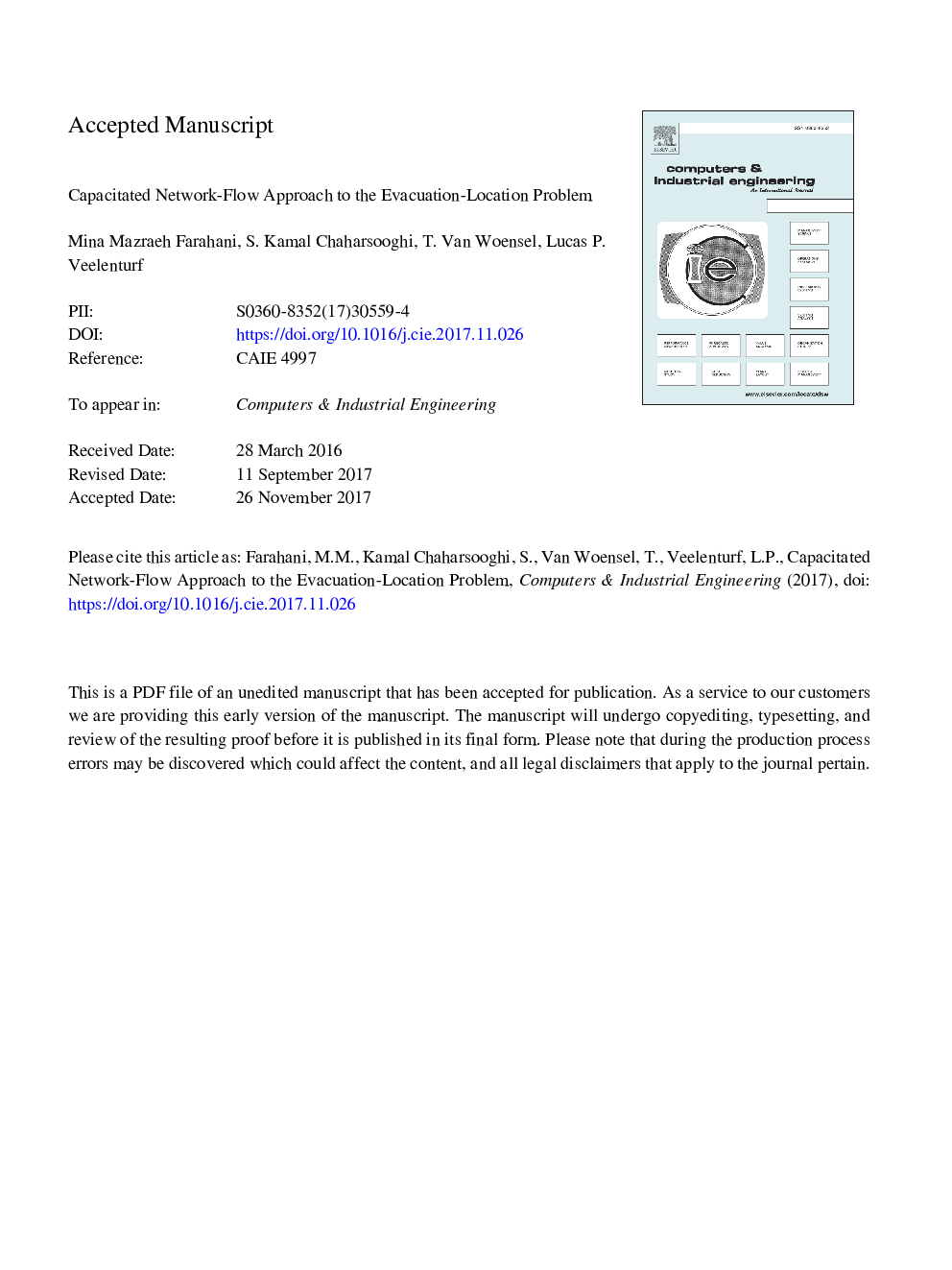| کد مقاله | کد نشریه | سال انتشار | مقاله انگلیسی | نسخه تمام متن |
|---|---|---|---|---|
| 7541640 | 1489051 | 2018 | 29 صفحه PDF | دانلود رایگان |
عنوان انگلیسی مقاله ISI
Capacitated network-flow approach to the evacuation-location problem
ترجمه فارسی عنوان
رویکرد جریان شبکه با ظرفیت بالا به مسئله محل تخلیه
دانلود مقاله + سفارش ترجمه
دانلود مقاله ISI انگلیسی
رایگان برای ایرانیان
کلمات کلیدی
تخلیه، مشکل محل سکونت اورژانس تدارکات، مشکل حداکثر جریان،
ترجمه چکیده
تخلیه مردم به مناطق امن مهمترین عملیات در مدیریت بسیاری از بلایای طبیعی است. در این مقاله یک مدل ریاضی ارائه شده است که ترکیبی از تصمیم گیری های موقعیت یابی با مساله حداکثر جریان به منظور انتخاب مقصد های ایمن است که حداکثر تعداد افراد ارسال شده را به حداکثر برساند. چارچوب موجود برای تدارکات اورژانس معمولا روند تخلیه را بر اساس مقصد ثابت و پیش تعیین شده با یک دیدگاه استراتژیک مدل می کند. ماهیت غیر قابل پیش بینی و آشفتگی یک فاجعه ممکن است؛ با این حال، پیش بینی ها را مختل می کند. علاوه بر این، هدف اصلی در شرایط اضطراری، اعزام مردم از منطقه خطر به مکان امن، بدون توجه به کجاست. یک مدل برنامه ریزی خطی مختلط در این مقاله برای انتخاب یک یا چند مقصد در یک شبکه ظرفیتی توسعه یافته است. ساختار خاصی از مدل و شباهت آن به مشکل حداکثر جریان، ما را قادر می سازد تا الگوریتم های دقیق و اکتشافی را برای هر دو مسئله موقعیت مکانی چند و چندگانه توسعه دهیم. روش های راه حل مبتنی بر الگوریتم های موجود برای مشکل حداکثر جریان است. اکتشافات پیشنهادی ما از ایده اضافه کردن یک سوپر سینک به شبکه برای تولید مرزهای بالایی بسیار سریع استفاده می کنند. الگوریتم های دقیق و همچنین اکتشافی ها بر روی نمونه های به صورت تصادفی تولید شده و همچنین یک شبکه دنیای واقعی آزمایش می شوند. مهمترین آمار مربوط به زمان محاسبه آنها گزارش شده است. آنها همچنین با توجه به عملکرد آنها (فاصله به مطلوبیت) و رفتار آنها در میان مقادیر مختلف نمودارها مقایسه می شوند. در نهایت، یک پرونده واقعی را در مورد انتخاب تعدادی از مکان های مقصد از یک مجموعه ثابت از مکان های پیش تعیین شده آزمایشی ارائه داده ایم. مشکل تصمیم گیری در مورد مقصد در زیر 5 نمره شدت فاجعه محسوب می شود و تاثیرات مربوط به انتخاب مناطق ایمن مورد تجزیه و تحلیل قرار می گیرد.
موضوعات مرتبط
مهندسی و علوم پایه
سایر رشته های مهندسی
مهندسی صنعتی و تولید
چکیده انگلیسی
Evacuating people to the safe zones is the most crucial operation in managing many disasters. A mathematical model is presented in this paper, combining locational decisions with the max-flow problem in order to select safe destinations which maximize the number of dispatched people. The existing frameworks for emergency logistics usually model the evacuation process based on fixed and pre-determined destinations with a strategic perspective. The unpredictable and turbulent nature of a disaster may; however, disrupt the predictions. Furthermore, the primary goal in emergency situations is to dispatch people from the danger zone to a safe place, no matter where. A mixed integer linear programming model is developed in this paper for selecting one or more destinations in a capacitated network. The special structure of the model and its similarity to the max-flow problem allow us to develop exact algorithms and heuristics both for the multiple and single destination location problem. The solution methods are based on existing algorithms for the max-flow problem. Our proposed heuristics use the idea of adding a super-sink to the network to generate upper bounds very fast. The exact algorithms as well as the heuristics are tested on randomly generated instances as well as a real world network. The most important statistics of their computation times are reported. They are also compared according to their performance (gap to optimality) and their behavior amongst different categories of the graphs. Finally we have presented a real-case addressing the problem of choosing a number of destination locations from a fixed set of pilot pre-determined locations. The problem of deciding on the destinations is considered under 5 grades of disaster severity and the related impacts on choosing the safe zones are analyzed.
ناشر
Database: Elsevier - ScienceDirect (ساینس دایرکت)
Journal: Computers & Industrial Engineering - Volume 115, January 2018, Pages 407-426
Journal: Computers & Industrial Engineering - Volume 115, January 2018, Pages 407-426
نویسندگان
Mina Mazraeh Farahani, S. Kamal Chaharsooghi, T. Van Woensel, Lucas P. Veelenturf,
